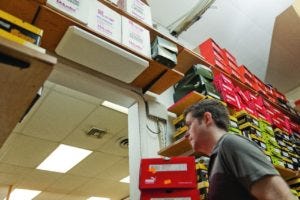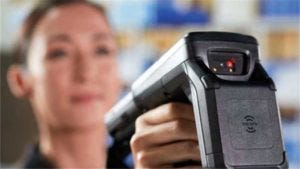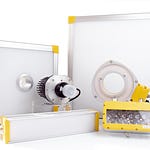There are many methods and technologies for identifying and locating things and people. For over 40 years, Global Automation and Identification Group has worked with all of them. One technology that is superior in many applications is RFID. Here is an introduction to RFID, courtesy of our solutions partner, Barcom Inc.
What is RFID?
RFID stands for radio frequency identification. RFID is a technology that uses radio waves to automatically locate, identify and track items using RFID tags.
An RFID tag is encoded with a unique identifier and is adhered to an object. The unique identifier is tied to a database and used to identify the object and pinpoint its location to within a few feet. The tag also contains wireless transmitters that transmit data and information wirelessly, much like Wi-Fi does.
Tags are read wirelessly and automatically when they come within range of an RFID reader. Read range is dependent upon the technology of the reader, whether the tags are active or passive, and even the amount of interference from other devices.
In general, however, passive tags are read within a few feet of the reader, but could be read within more than 20 feet under the right conditions.
RFID readers are usually handheld mobile readers or fixed readers installed above doorways or in another strategic location. Fixed readers are used to create an automated system that reads tags as they pass by the reader.
RFID software is used to interpret tag data and update related information about each tagged item in a database, such as its location and status.
What are the advantages of RFID vs. barcoding?
With RFID technology, data is collected and recorded as material passes through. This makes the job more efficient from an accuracy and productivity standpoint because RFID does not require the user to enter data manually. Instead, data is recorded instantaneously as tagged materials pass through the antenna/reader.
Unlike a barcode, line of sight is not required to read an RFID tag. Tags are read wirelessly and remotely, even if they’re not physically visible or accessible. They are readable as long as the reader is within your tag’s radio range.
You can read multiple tags at a time, so you can identify, track and locate an entire room’s worth of inventory without manual, item-by-item scanning.
You can also use RFID for real-time tracking of assets as they move through processes or through different areas of a building, especially if you’re using fixed RFID readers at entryways or in aisles.
In short, with RFID:
Inventory counts are completed in a matter of hours, not days
Materials are located quickly and efficiently
You can easily identify assets and equipment moved to an unauthorized location or removed from the building
You can boost worker productivity and dramatically reduce errors
Where is RFID used?
RFID can be used in any application where you need to identify, locate and track inventory, assets or shipments. Some of the most common industries and applications where RFID is used are:
Retail
Warehousing
Yard Management
Manufacturing
Transportation & Logistics
Healthcare
Energy & Utilities
Aerospace & Defense
Types of RFID devices
The type of RFID devices you need depends largely on the requirements of your unique application. From handheld devices and fixed readers, to RFID printers, antennas and tags, you can count on this technology to speed up operations and provide error-free, automated tracking of goods and materials.
There’s more to RFID than hardware and supplies.
Although the technology is an efficient way to streamline operations, it’s not a one-size-fits-all solution for every application or environment. Leveraging the expertise of an engineer who can examine your current workflow, understand the types of material and items being tracked, and establish the right kind of tag or label you need will be helpful in putting together a well-planned RFID strategy.
To learn more about RFID for your business, and to learn more about our solutions partner, Barcom, Inc., contact GlobalAutoID at GlobalAutoID.com/contact.
Follow GlobalAutoID on Twitter @GlobalAutoID, and on LinkedIn by visiting GlobalAutoID.com/LinkedIn.
This audiocast was produced and presented by James D Kirk for Global Automation & Identification Group. Thank you for your time and attention, be well, and have a successful week.
The audiocast background music is Funkorama by Kevin MacLeod.
Link: https://incompetech.filmmusic.io/song/3788-funkorama
License: http://creativecommons.org/licenses/by/4.0/















